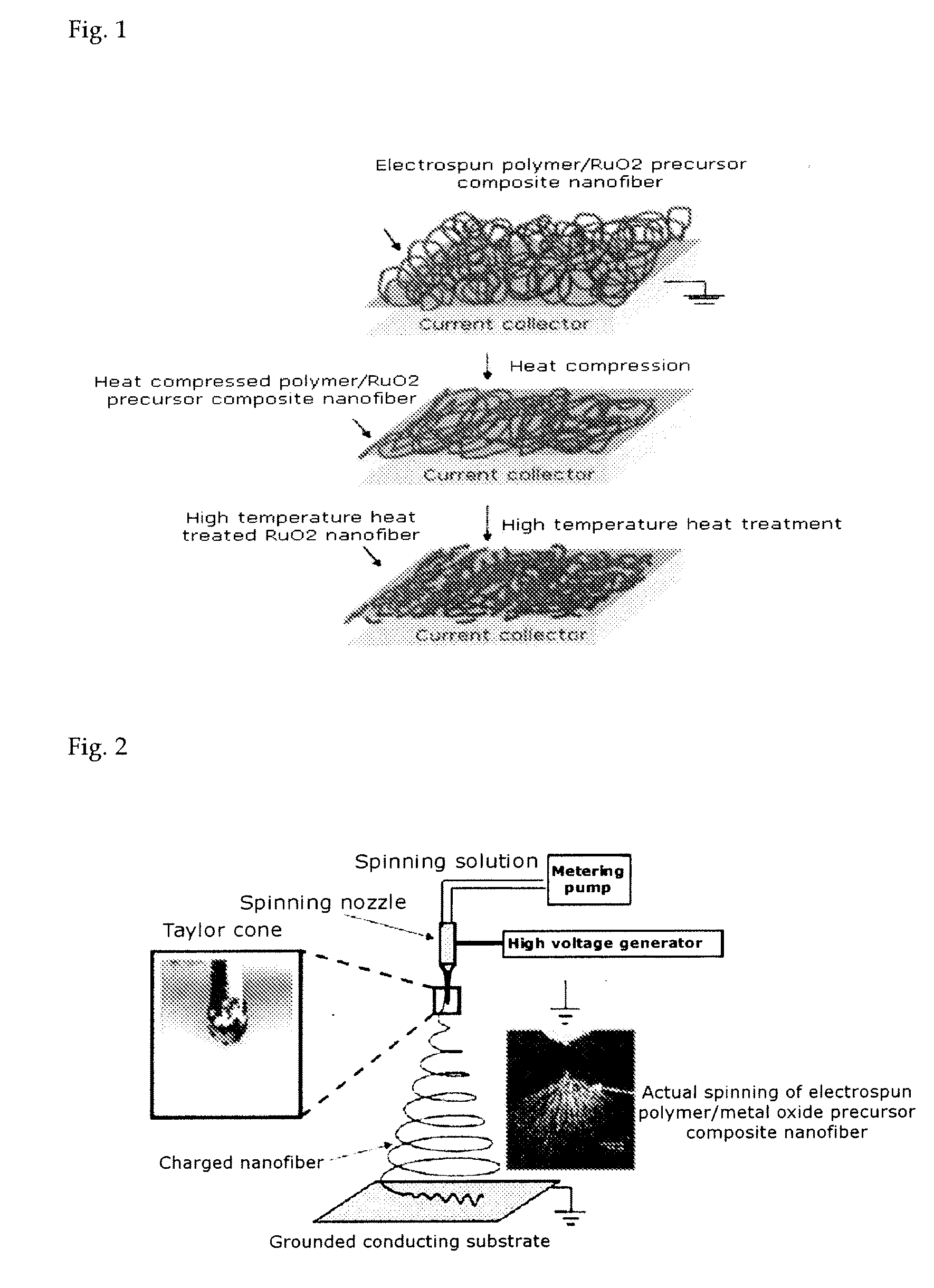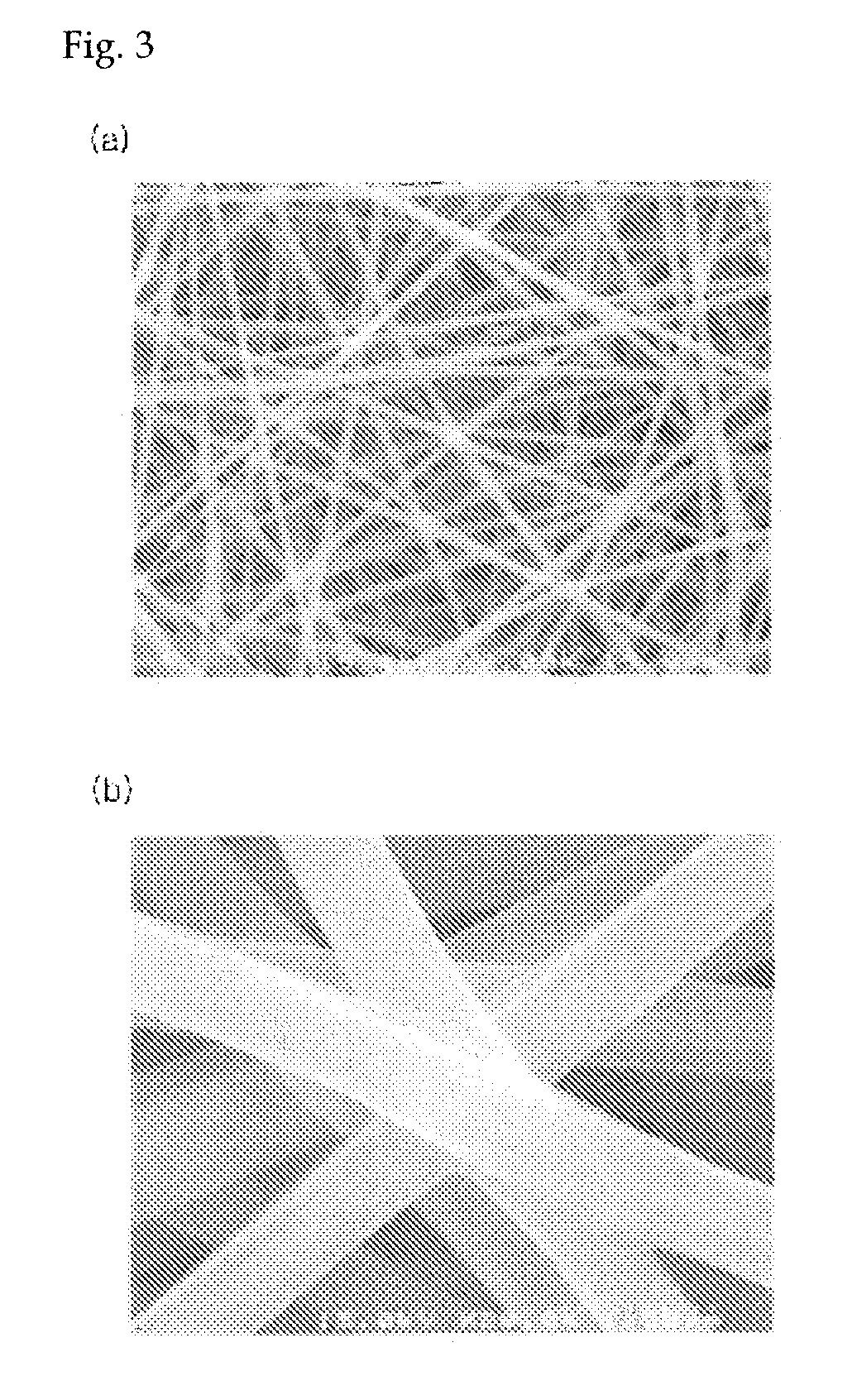Conductive electrode using metal oxide film with network structure of nanograins and nanoparticles, preparation method thereof and supercapacitor using the same
- Summary
- Abstract
- Description
- Claims
- Application Information
AI Technical Summary
Benefits of technology
Problems solved by technology
Method used
Image
Examples
example 1
Preparation of Ruthenium Oxide Nanofiber Network Through Preparation of Ruthenium Oxide Precursor-Polyvinyl Acetate Composite Fiber Layer and Post Heat Treatment
[0078]1.6 g of polyvinyl acetate (molecular weight: 1,000,000) was dissolved in 20 mL of dimethylformamide for about a day. 5 g of ruthenium(III) chloride hydrate (RuCl3-nH2O) was added to the resultant polymer solution and dissolved by mixing. Because ruthenium(III) chloride hydrate dissolves well in DMF, acetic acid may not be used for enhancing catalytic reaction. Following the reaction, the precursor was transferred to a syringe. The syringe was mounted on an electrospinning apparatus and a voltage was applied between the syringe tip and the current collector to prepare a ruthenium precursor-polyvinyl acetate composite fiber layer. Here, the applied voltage was 10 kV, flow rate was 5 μL / min, total ejection amount was 600 μL, and distance between the tip and the current collector was about 17.5 cm. In the ruthenium precur...
example 2
Preparation of Ruthenium Oxide Nanofiber Network Comprising Nanograins and / or Nanoparticles Through Heat Compression and Post Heat Treatment of Ruthenium Precursor-Polyvinyl Acetate Composite Fiber Layer
[0085]The ruthenium precursor / polyvinyl acetate composite fiber prepared in Example 1 was pressed using a lamination machine (120° C., pressing pressure: 0.1 MPa, pressing time: 90 seconds) and baked at 450° C. for 30 minutes to prepare a ruthenium oxide network comprising nanograins and / or nanoparticles. The surface structure varies depending on the pressing pressure and time. Further, the heat pressing temperature can be varied depending on the glass transition temperature of the polymer used. Especially, the size of nanograins can be easily controlled by controlling the heat treatment temperature.
[0086]FIG. 8 shows an SEM image of a RuO2 / PVAc composite fiber prepared by electrospinning in accordance with the present invention, after heat compressing (120° C., 90 seconds, 0.1 MPa)....
example 3
Preparation of Iridium Oxide Nanofiber Network Comprising Nanograins and / or Nanoparticles Through Heat Compression and Post Heat Treatment of Iridium Precursor-Polyvinyl Acetate Composite Fiber Layer
[0093]In order to prepare conducting metal oxide IrO2 listed in Table 1, iridium(III) chlorite hydrate (298.56 g / mol) was dissolved in dimethylformamide (DMF). Polyvinyl acetate (PVAc, molecular weight: 500,000 to 1,000,000) was dissolved in the DMF solution of the iridium precursor. Following the reaction, the precursor was transferred to a syringe. The syringe was mounted on an electrospinning apparatus and a voltage was applied between the syringe tip and the current collector to prepare an iridium precursor-polyvinyl acetate composite fiber layer. Here, the applied voltage was 10 kV, flow rate was 5 μL / min, total ejection amount was 600 μL, and distance between the tip and the current collector was about 17.5 cm. In the iridium precursor-polyvinyl acetate composite fiber layer formed...
PUM
| Property | Measurement | Unit |
|---|---|---|
| Temperature | aaaaa | aaaaa |
| Temperature | aaaaa | aaaaa |
| Temperature | aaaaa | aaaaa |
Abstract
Description
Claims
Application Information
 Login to View More
Login to View More - R&D
- Intellectual Property
- Life Sciences
- Materials
- Tech Scout
- Unparalleled Data Quality
- Higher Quality Content
- 60% Fewer Hallucinations
Browse by: Latest US Patents, China's latest patents, Technical Efficacy Thesaurus, Application Domain, Technology Topic, Popular Technical Reports.
© 2025 PatSnap. All rights reserved.Legal|Privacy policy|Modern Slavery Act Transparency Statement|Sitemap|About US| Contact US: help@patsnap.com



